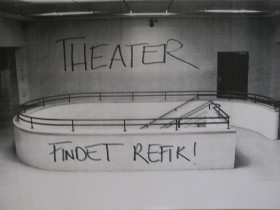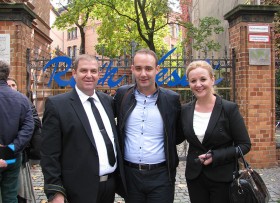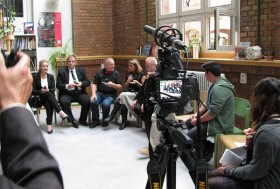
A scene from the theater play, “Findet Refik!” © Lernkultur – Institut für Bildungsforschung und Evaluation, photo: Katharina Obens
The recently approved introduction of upper secondary level teaching at the Refik-Veseli-School was a first for Kreuzberg 36, an inner-city district of Berlin, which is very popular. Now, local kids from the neighborhood called “Wrangelkiez” need no longer travel to other districts to study for the “Abitur,” Germany’s high school diploma. This is a major step towards assuring non-segregated educational opportunities in Kreuzberg
The 8th Integrated High School in the downtown district of Kreuzberg-Berlin sealed its partnership with the Jewish Museum Berlin in June 2012. Prior to that, all the staff and pupils had voted on a new name for their school and decided to call it the Refik-Veseli-School. For during a study trip to Israel, pupils had visited the Yad Vashem Museum and learned about the history of Refik Veseli—a man acknowledged being Righteous Among the Nations.
Refik Veseli was a 17-year-old apprentice in a photo studio in Tirana, Albania, when he first met the Jewish photographer Mosche Mandil, who had fled Yugoslavia to escape the National Socialists. But in 1943 the Germans invaded Albania too, and things became much more dangerous for Jews. The Veseli family owned a house in Kruje and decided to hide Mosche Mandil and his family there. It turned out to be a three-year commitment.
In 1987, Yad Vashem awarded the Veseli family the honorary title Righteous Among the Nations. The Veselis were the first ever Albanians to be honored this way in Israel. From 1943 to 1945, the tiny country of Albania—where only around 200 Jews lived before the Holocaust—took in between 600 and 1,800 Jewish refugees from all over Europe, whom Muslim families then helped survive in hiding during the German occupation. Albania is the only country in Europe to have had more Jewish residents after 1945 than before the Holocaust. One reason for this may be the code of honor by which practicing Muslims there live: besa meaning “to keep a promise.” Many Albanian families took care of people fleeing persecution, just as this commandment requires; and likewise the Veselis never once asked themselves whether they should help Jewish refugees, but discussed in their family council only how this might be possible.

The Veselay family at the entrance to the Refik Veseli School © Lernkultur – Institut für Bildungsforschung und Evaluation, photo: Katharina Obens
Now, in the new guiding principles formulated by the first school ever named after Refik Veseli, one can read that, “the namesake Refik Veseli represents our ideal, which is to accept and acknowledge diversity. Against a backdrop of democratic consensus, he committed himself with youthful civil courage to defending the human rights of a persecuted people (…) Refik Veseli is a role model for us all, on our way towards building an inclusive society with a plural democracy.”
School Director Ulrike Becker firmly believes in the value of the educational partnership with the Jewish Museum, which was launched almost three years ago. She told me that it represents “a vital step towards establishing cultural and religious acceptance at our school.” Furthermore, “intensification of the mentoring partnership with the Jewish Museum Berlin” is now an integral part of the new school program, as is “regular discussion of (and whenever possible, attendance at) educational events organized by the Jewish Museum.”

The Veselay and Mandil families in conversation on 8.10.2014 © Lernkultur – Institut für Bildungsforschung und Evaluation, photo: Katharina Obens
As part of the celebrations accompanying the official re-naming ceremony at the school on 8 October 2014, a dance performance took place at the Jewish Museum Berlin. Cilly Kugelmann, Program Director, spoke to the many schoolchildren, teachers and guests in attendance at the school. Guests of honor were the children and grandchildren of both families. A close friendship and a shared passion for photography link the Mandils and the Veselays to this day.
I asked the two families a question:
What first came to mind when you heard that this school in Berlin was to be renamed the Refik-Veseli-School?
Ron Veselay (Refik Veseli’s grandson): “I cried the day Ruth Mandil told me the news. Well, it seemed incredible to me, to be honest. I would never have thought it possible; it was incredible. It’s a great honor for me, that the school is named after my grandfather, who unfortunately died back in the year 2000. We now hope that the message carried by his name will reach people. For the friendship between the Veseli and Mandil families has never ceased to grow stronger. I’m even called Ron, after all, just like Ron Mandil! So we were very happy when we heard the news; and I hope that this new name will forge bridges between generations, religions and nations.”
Ron Mandil (Moshe Mandil’s grandson): “At first, we didn’t understand what the point of the project was supposed to be. It was only when we arrived here yesterday and saw the sign over the school entrance that we really began to understand what it was all about. That was a very emotional moment for us. It’s incredible that the schoolchildren here have named their school after Refik Veseli—after Refik, who saved our family from the Holocaust. It is a great honor for us—because this way, our family histories, the history of the Veselis and that of the Mandils, become a part of a bigger history. Yesterday, when we arrived, a schoolgirl asked us ‘Are you the Veseli family?’ and we replied, ‘No, we are the Mandils.’ And she said ‘Oh, then your grandfather was Moshe Mandil?’ It was so astonishing that this German girl knew my own personal history. It was incredible and very moving. Now here we are in Germany, in Berlin, in a school named after Refik Veseli. I find that a very optimistic turn of events!”
Ruth Mandil: “You know we have been researching our family history and the Second World War for many years now. We’ve known the name Refik Veseli practically since the day we were born. Our father Gavra Mandil talked a lot about the three years he spent in hiding in the Veselis’ house. But it is only now, at this ceremony that all those feelings come rushing back. I’ve told everyone I know about this, back home in Tel Aviv. And whenever I think about it, my eyes fill with tears. It is totally overwhelming to be able to be present at this re-naming ceremony. As Ron said, this is a private, personal history but it no longer belongs only to us. It’s a part of global history, now.
Katharina Obens, free associate of the Jewish Museum Berlin who went to Kreuzberg 36 to meet the two families